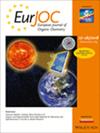Asymmetric Hydrosilylation of Ketones Catalyzed by Diaminocyclohexane/Zinc Complexes: A Comparative Study and Mechanistic Insight
IF 2.7
3区 化学
Q2 CHEMISTRY, ORGANIC
引用次数: 0
Abstract
The catalytic enantioselective hydrosilylation activity of zinc is investigated in the presence of two ligands derived from cyclohexane‐1,2‐diamine: N,N′‐dibenzylcyclohexane‐1,2‐diamine (1) and a cage‐like structure composed of six cyclohexane‐1,2‐diamine units (2). The reaction proceeds rapidly, achieving complete conversion within minutes and affording alcohol products with enantiomeric excesses of up to 94%. Despite the favorable results with the cage‐like ligand (2), no significant advantage over ligand (1) is observed. In a second part, to gain insight into the reaction mechanism, various mechanistic experiments are conducted alongside density functional theory calculations. The findings suggest that ligand‐selective silylation leads to the formation of a zinc hydride species, which is likely the active catalytic intermediate in this system.二氨基环己烷/锌配合物催化酮类不对称硅氢化反应的比较研究及其机理
在两种由环己烷- 1,2 -二胺衍生的配体:N,N ' -二苄基环己烷- 1,2 -二胺(1)和由六个环己烷- 1,2 -二胺单元组成的笼状结构(2)的存在下,研究了锌的催化对映选择性硅氢化活性。反应进行迅速,在几分钟内实现完全转化,并提供酒精产品的对映体过量高达94%。尽管笼状配体(2)具有良好的效果,但与配体(1)相比没有明显的优势。在第二部分,为了深入了解反应机理,在密度泛函理论计算的基础上进行了各种力学实验。研究结果表明,配体选择性硅基化导致氢化锌的形成,这可能是该体系中的活性催化中间体。
本文章由计算机程序翻译,如有差异,请以英文原文为准。
求助全文
约1分钟内获得全文
求助全文
来源期刊
CiteScore
5.40
自引率
3.60%
发文量
752
审稿时长
1 months
期刊介绍:
The European Journal of Organic Chemistry (2019 ISI Impact Factor 2.889) publishes Full Papers, Communications, and Minireviews from the entire spectrum of synthetic organic, bioorganic and physical-organic chemistry. It is published on behalf of Chemistry Europe, an association of 16 European chemical societies.
The following journals have been merged to form two leading journals, the European Journal of Organic Chemistry and the European Journal of Inorganic Chemistry:
Liebigs Annalen
Bulletin des Sociétés Chimiques Belges
Bulletin de la Société Chimique de France
Gazzetta Chimica Italiana
Recueil des Travaux Chimiques des Pays-Bas
Anales de Química
Chimika Chronika
Revista Portuguesa de Química
ACH—Models in Chemistry
Polish Journal of Chemistry.

 求助内容:
求助内容: 应助结果提醒方式:
应助结果提醒方式:


